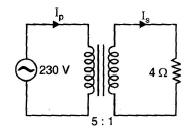Test: D.C Machines & Transformers - 1 - Electrical Engineering (EE) MCQ
25 Questions MCQ Test - Test: D.C Machines & Transformers - 1
If the number of conductors and speed of a lap wound generator is doubled then the generated emf will be
A transformer has an efficiency of 80% and works at 100 V, 4 kW. If the secondary voltageis 240 V, find the primary current.
A 2000/ 200V, 20 kVA ideal transformer has 66 turns in the secondary. The number of primaryturns is ......
The no-load primary current I0 is about ...... of full-load primary current.
A transformer takes a current of 0.6 A ad absorbs 64 W when the primary is connected to its normalsupply of 200 V, 50 Hz, the secondary being on open-circuit. The iron loss current is ..........
In Figure, the primary will see an impedance of .......

A 40 kVA transformer has iron loss of 450 W and full-load copper loss of 850 W. If the powerfactor of the load is 0.8 lagging, the full-load efficiency of the transformer is
How are transformers generally cooled for installations rated at less than 5 kVA ?
The full-load copper losses and iron losses of a transformer are 6400 W and 5000 Wrespectively. The copper loss and iron loss at half full-load will be respectively.
The transformer that does not provide electric isolation is
What is/ are the advantage/advantages of 3-phase transformer over 3 single-phase bank oftransformers ?
The autotransformer is preferably employed in situation where voltage transformetion ratio (K)is
The all-day efficiency of a transformer is also called its
To produce dynamically induced emf, the following is (are) necessary
Function of _____ is to collect current from the commutator and supply it to the external load.
A 6 pole wave wound d.c. generator has 460 armature conductors carrying armature current of 180 A. The armature reaction demagnetizing and cross magnetizing ampere turns per pole if brushes are shifted by 6 degree electrical from G.N.A are
Armature reaction in a d.c. motor is increased......
Wave winding is employed in a dc machine of
The armature MMF waveform of a dc machine is
The type of dc generator used for arc welding purposes is a
Which type of motors are preferred in lifts?
What is the increase in torque expressed as percentage of initial torque, if the current drawnby a dc series motor is increased from 10 A to12 A (neglect saturation )?














